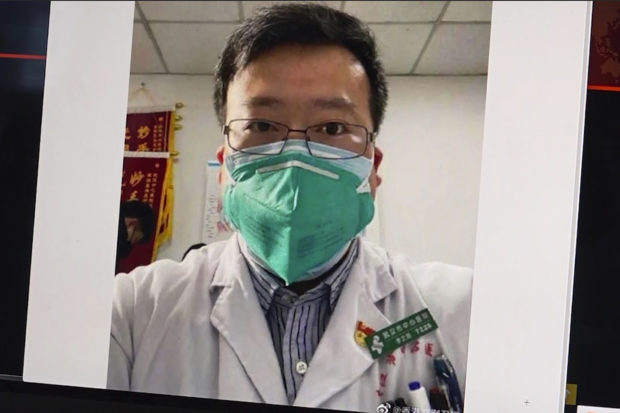
This image from video, shows a selfie of Dr. Li Wenliang. The Chinese doctor who got in trouble with authorities in the communist country for sounding an early warning about the coronavirus outbreak died Friday, Feb. 7, 2020, after coming down with the illness. The Wuhan Central Hospital said on its social media account that Dr. Li, a 34-year-old ophthalmologist, was “unfortunately infected during the fight against the pneumonia epidemic of the new coronavirus infection.” (AP Photo)
BEIJING — A Chinese doctor who was punished after raising the alarm about China’s China’s novel coronavirus (2019-nCoV) died from the pathogen on Friday, sparking an outpouring of grief and anger over a worsening crisis that has now killed more than 630 people.
At least 31,000 people have now been infected by a virus that ophthalmologist Li Wenliang and colleagues had first brought to light in late December 2019.
The disease has since spread across China, prompting the government to lock down cities of tens of millions of people, while the global panic has risen as more than 240 cases have emerged in two dozen countries.
A quarantined cruise ship in Japan now has 61 confirmed cases.
Chinese President Xi Jinping and US President Donald Trump, whose countries have tussled over trade and human rights, spoke on the phone about the health emergency on Friday.
Xi urged “the US side to respond reasonably to the novel coronavirus outbreak”, according to the official Xinhua news agency.
Trump expressed his “confidence” in China’s ability to tackle the epidemic, the White House said.
Beijing has been angered by bans on arrivals from China instituted by the United States and other countries, accusing Washington of spreading “panic”.
Li, 34, died early Friday, Wuhan Central Hospital said in a post on China’s Twitter-like Weibo platform, an announcement that triggered grief on social media – over a doctor who was hailed a hero – and anger over the government’s handling of the crisis.
“He is a hero who warned others with his life,” a fellow Wuhan doctor wrote on Weibo after reports of his death emerged.
“Those fat officials who live on public money, may you die from a snowstorm,” wrote one angry Weibo user in a comment that has since been censored.
Death censored
Li’s death also highlights the enormous risks that frontline doctors have taken to treat patients in overwhelmed and under-equipped hospitals in Wuhan, the quarantined city of 11 million people where the virus emerged in December.
Medical staff has been overstretched as they lack sufficient protective gear, the deputy governor of Hubei province admitted Thursday.
Li sent out a message about the new coronavirus to colleagues on December 30 in Wuhan – the central city at the epicenter of the crisis – but was later among eight whistleblowers summoned by police for “rumor-mongering”.
He later contracted the disease while treating a patient.
Censors appeared to struggle with how to deal with his death.
State-run newspaper Global Times and state broadcaster CCTV first reported on Weibo that Li had died late Thursday, only to delete their posts after the death rapidly surged to be among the top topics on the popular platform.
The World Health Organization reacted to the first reports of his death to express sadness.
Analysts have said that local authorities played down the extent of the outbreak in early January because they were holding political meetings at the time and wanted to project an aura of stability.
The first fatality was reported on January 11. The death toll has since soared to 636, with 73 more reported on Friday and an additional 3,000 new infections.
In this Wednesday, Feb. 5, 2020, photo, a medical worker in a protective suit walks by patients who diagnosed with the coronaviruses settle at a temporary hospital which transformed from an exhibition center in Wuhan in central China’s Hubei province. Ten more people were sickened with a new virus aboard one of two quarantined cruise ships with some 5,400 passengers and crew aboard, health officials in Japan said Thursday, as China reported 73 more deaths and announced that the first group of patients was expected to start taking a new antiviral drug. (Chinatopix via AP)
Global spread
The virus is believed to have emerged from a market selling exotic animals in Wuhan before jumping to humans and spreading across China and abroad as millions traveled for the Lunar New Year holiday.
Some 56 million people in Wuhan and surrounding cities have been ordered to stay home, while several countries have banned arrivals from China and advised their citizens to leave.
Major airlines have suspended flights to and from the country.
But cases keep emerging.
Two cruise ships carrying thousands of holidaymakers in Hong Kong and Japan have been placed under quarantine as authorities test people for infections.
On Friday another 41 people tested positive aboard the Diamond Princess in Japan, bringing the total number of infected cases on the ship to 61.
There were 3,700 people aboard the ship when it arrived in Japanese waters.
Prime Minister Shinzo Abe said Thursday another cruise ship, the Westerdam, was heading to the country with one confirmed case, and no foreigners would be allowed to disembark.
In Hong Kong, 3,600 people spent a second night confined aboard the World Dream, where eight former passengers have tested positive for the virus.
Hong Kong has been particularly nervous because the crisis has revived memories of Severe Acute Respiratory Syndrome (SARS). That killed nearly 300 people in the city and another 349 on the Chinese mainland in 2002-2003.
While the death toll continues to rise, experts have stressed that at two percent mortality, 2019-nCoV is far less deadly than SARS, which killed around 10 percent of the people it infected 17 years ago.
The outbreak has nevertheless been declared a global health emergency.
RELATED STORY
China launches probe after whistleblower doctor dies